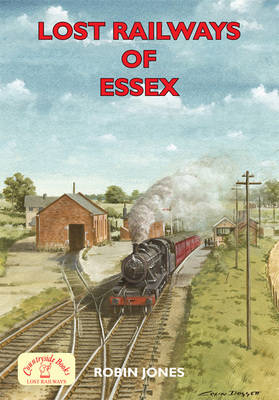Lost Railways
1 total work
This illustrated and carefully researched book takes you back to the golden age of railways in Essex - to a time of thriving rural railways, bustling local stations and steam trains pulling liveried coaches across the countryside.
Author Robin Jones brings the story of Essex's railways vividly to life here - the reasons for their construction and for their subsequent closure.
In March 1843 rural Essex moved into the railway age when the first passenger trains began to run between London Shoreditch and Colchester. More schemes quickly followed, connecting the capital with outlying areas. Many of them are still with us today as busy commuter lines.
Subsequent routes helped to create the county's tourist trade, promoting the growth of holiday resorts such as Clacton-on-Sea, Southend-on-Sea and Walton-on-the-Naze. Others sought to link with shipping and dock services, in particular, along the north bank of the Thames, where new ports and waterfronts fed industries built on reclaimed swathes of desolate marshland. The railways kept this hive of activity moving around the huge artificial harbours that had been created to serve the Port of London.
Many stations on these lines have now been lovingly restored as private homes. Some of the old trackbeds survive as footpaths and cycle routes, and there is still much for the rambler, railway historian and interested local resident to explore.
Modern photographs accompany those from earlier times. These, together with specially drawn maps, will help those who wish to explore the old lines and stations that have survived.
Author Robin Jones brings the story of Essex's railways vividly to life here - the reasons for their construction and for their subsequent closure.
In March 1843 rural Essex moved into the railway age when the first passenger trains began to run between London Shoreditch and Colchester. More schemes quickly followed, connecting the capital with outlying areas. Many of them are still with us today as busy commuter lines.
Subsequent routes helped to create the county's tourist trade, promoting the growth of holiday resorts such as Clacton-on-Sea, Southend-on-Sea and Walton-on-the-Naze. Others sought to link with shipping and dock services, in particular, along the north bank of the Thames, where new ports and waterfronts fed industries built on reclaimed swathes of desolate marshland. The railways kept this hive of activity moving around the huge artificial harbours that had been created to serve the Port of London.
Many stations on these lines have now been lovingly restored as private homes. Some of the old trackbeds survive as footpaths and cycle routes, and there is still much for the rambler, railway historian and interested local resident to explore.
Modern photographs accompany those from earlier times. These, together with specially drawn maps, will help those who wish to explore the old lines and stations that have survived.
